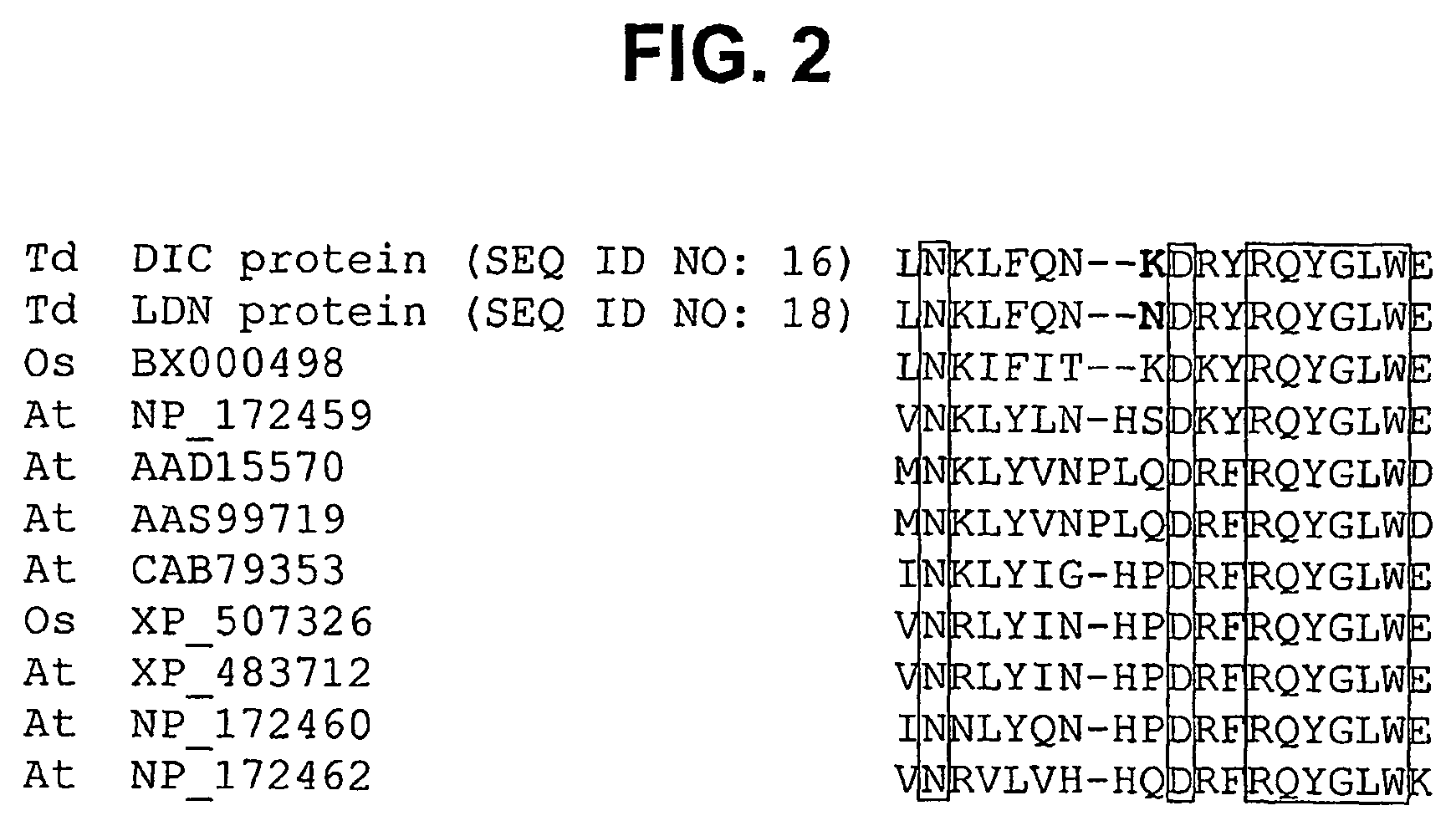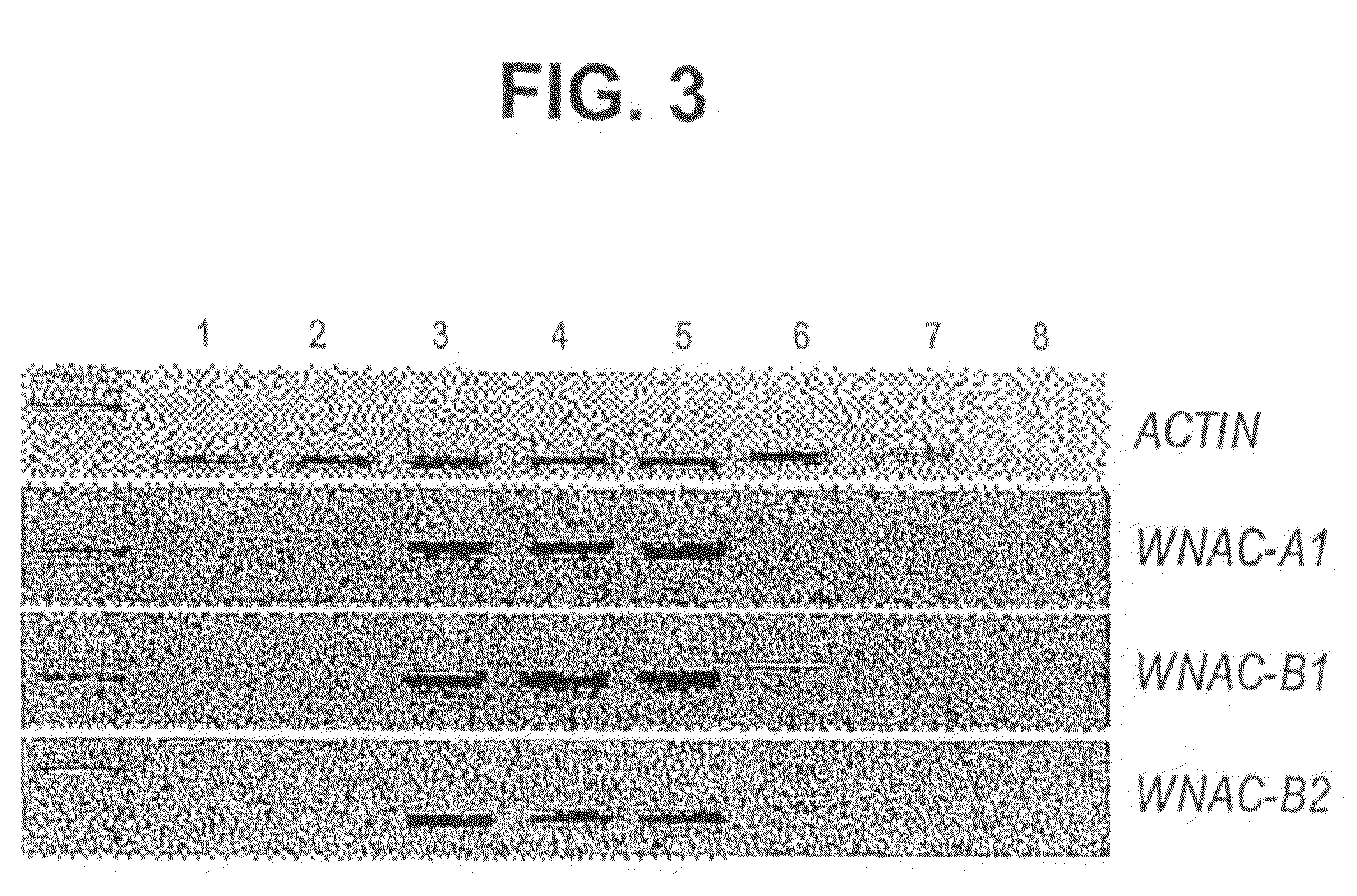NAC from wheat for increasing grain protein content
a technology of grain protein and nac, which is applied in the field of plant molecular biology and plant breeding, can solve the problems of slow gene improvement of this trait by conventional breeding, and achieve the effects of increasing the mrna or protein level encoded, increasing the activity of wnac-1 protein, and increasing the rate of senescence in plants
- Summary
- Abstract
- Description
- Claims
- Application Information
AI Technical Summary
Benefits of technology
Problems solved by technology
Method used
Image
Examples
example 1
Identification of Gene Responsible for High Grain Protein Content in Wheat
[0112]Background Efforts to improve GPC without selecting for low yield can be accelerated by the identification of the genes that affect GPC and the direct selection of the alleles with positive effects.
[0113]A promising source of high GPC was detected in a survey of wild populations of tetraploid Triticum turgidum ssp. dicoccoides (accession FA-15-3) referred as dicoccoides or DIC hereafter (Avivi, L., Indian Soc. Geinet. Plant Breed., New Delhi, pp. 372-380 (1978)). Cantrell, R. G., and L. R. Joppa., Crop Science 31:645-649 (1991) developed complete sets of disomic substitution lines from each of the chromosomes of this dicoccoides accession into the tetraploid durum cultivar Langdon (LDN). The substitution of the complete chromosome 6B of DIC into LDN [LDN(DIC-6B)] showed the highest protein yield. This significant increase in GPC was not associated with a significant decrease in grain yield or kernel weig...
example 2
Effect of the Allelic Variation at the Gpc-B1 Locus on Senescence
[0148]Allelic variation at the Gpc-B1 locus has other effects in addition to the observed difference in GPC. A field study comparing several RSLs carrying the WNAC-B1a allele with other carrying the WNAC-B1b allele (Davis, Calif., 2004, split plot design, 20 blocks) showed that the lines with the WNAC-B1 a senesce faster than the lines with the WNAC-B1b allele after anthesis. No significant differences were detected in ear emergence or time of anthesis between the two alleles indicating that the differences in maturation were due to differences in senescence / maturation rates. A few days after the first symptoms of senescence, the RSLs with the WNAC-B1 a allele showed a significantly higher percent of yellow peduncles (P<0.001) and a significantly lower water content in the spikes (P<0.001) than the lines with the WNAC-B1b allele. Lines with WNAC-B1a allele had an average humidity of 25.9% versus lines with LDN allele t...
example 3
WNAC-B1 Orthologues in Rice and Maize
[0152]WNAC-B1 Orthologue in Rice.
[0153]The complete genomic sequence of rice was searched to identify the closest homologue of WNAC-B1 in rice (SEQ ID NOS:28 and 29). One rice NAC protein was identified (OsNAC) that had 98% similarity to WNAC-B1 at the protein level within the NAC domain (115 of 117 amino acid residues). This high level of similarity dropped to 84% with the second highest score in the blast search (OsNAC-A). FIG. 4 displays a multiple sequence alignment of the 75 NAC proteins previously reported by Ooka, H., et al., DNA Research 10:239-247 (2003) and the wheat WNAC-B1 protein, followed by a phylogenetic analysis (neighbor-joining method). OsNAC and WNAC-B1 clustered together, while OsNAC-A and all the other rice NAC proteins were located on separate branches (complete tree not shown).
[0154]In addition, the promoter region of the WNAC-B1 and OsNAC genes was analyzed to find common regulatory elements. A 40-bp segment with perfect ...
PUM
| Property | Measurement | Unit |
|---|---|---|
| Tm | aaaaa | aaaaa |
| temperature | aaaaa | aaaaa |
| temperature | aaaaa | aaaaa |
Abstract
Description
Claims
Application Information
 Login to View More
Login to View More - R&D
- Intellectual Property
- Life Sciences
- Materials
- Tech Scout
- Unparalleled Data Quality
- Higher Quality Content
- 60% Fewer Hallucinations
Browse by: Latest US Patents, China's latest patents, Technical Efficacy Thesaurus, Application Domain, Technology Topic, Popular Technical Reports.
© 2025 PatSnap. All rights reserved.Legal|Privacy policy|Modern Slavery Act Transparency Statement|Sitemap|About US| Contact US: help@patsnap.com



